Formation of Fluorapatite in the Equilibrium System CaO–P2O5–HF–H2O at 298 K in a Nitrogen Atmosphere
Abstract
:1. Introduction
2. Materials and Methods
2.1. Sample Preparation
2.2. Characterization
3. Results
3.1. Section I
3.2. Section II
4. Conclusions
Supplementary Materials
Author Contributions
Funding
Data Availability Statement
Acknowledgments
Conflicts of Interest
References
- Ptáček, P. (Ed.) Phosphate rocks. In Apatites and Their Synthetic Analogues—Synthesis, Structure, Properties and Applications; InTech: Rijeka, Croatia, 2016; pp. 335–381. Available online: https://www.intechopen.com/chapters/49984 (accessed on 13 April 2016). [CrossRef]
- Van Wazer, J.R. Phosphorus and its compounds. In Chemistry; Wiley Interscience: New York, NY, USA, 1958; Volume 1, 2046p. [Google Scholar]
- Van Wazer, J.R. Phosphorus and its compounds. In Technology, Biological Functions and Applications; Interscience: New York, NY, USA, 1961; Volume 2, 957p. [Google Scholar]
- Baturin, G.N. Phosphorites on the Sea Floor. Origin, Composition and Distribution; Elsevier Scientific Publishing Company: Amsterdam, The Netherlands; Oxford, UK; New York, NY, USA, 1982; 355p. [Google Scholar]
- Ptáček, P. (Ed.) Utilization of apatite ores. In Apatites and Their Synthetic Analogues—Synthesis, Structure, Properties and Applications; InTech: Rijeka, Croatia, 2016; pp. 417–453. Available online: https://www.intechopen.com/chapters/49965 (accessed on 13 April 2016). [CrossRef]
- Leroy, N.; Bres, E. Structure and substitution in fluorapatite. Eur. Cells Mater. 2001, 2, 36–48. [Google Scholar] [CrossRef] [PubMed]
- Elliott, J.C. Structure and Chemistry of Apatite and Other Calcium Orthophosphates, 1st ed.; Elsevier: Amsterdam, The Netherlands, 1994; pp. 1–404. ISBN 0-444-81582-1. [Google Scholar]
- Farr, T.D.; Tarbutton, G.; Lewis, H.T. System CaO–P2O5–HF–H2O. J. Phys. Chem. 1962, 66, 318–321. [Google Scholar] [CrossRef]
- Kazakov, A.V. Fluorapatite equilibrium system under the conditions of sedimentary rock formation. Tr. Inst. Geol. Akad. Nauk SSSR Ser. Geol. 1950, 114, 7–21. [Google Scholar]
- Margolis, H.C.; Moreno, E.C.; Murphy, B.J. Effect of low levels of fluoride in solution on enamel demineralization in vitro. Dent. Res. 1986, 65, 23–29. [Google Scholar] [CrossRef] [PubMed]
- Yamazaki, H.; Litman, A.; Margolis, H.C. Effect of fluoride on artificial caries lesion progression and repair in human enamel: Regulation of mineral deposition and dissolution under in vivo-like conditions. Arch. Oral Biol. 2007, 52, 110–120. [Google Scholar] [CrossRef] [PubMed]
- Moreno, E.C.; Kresak, M.; Zahradnik, R.T. Physicochemical aspects of fluoride-apatite systems relevant to the study of dental caries. Caries Res. 1977, 11 (Suppl. 1), 142–171. [Google Scholar] [CrossRef] [PubMed]
- Arends, J.; Davidson, C.L. HPO42− Content in enamel and artificial carious lesion. Calcif. Tissue Res. 1975, 18, 65–79. [Google Scholar] [CrossRef] [PubMed]
- Verbeeck, R.M.H.; Thun, H.P.; Driessens, F.C.M. Solubility behaviour of defective fluorapatite and fluorhydroxyapatites. Ber. Bunsenges Phys. Chem. 1980, 84, 159–163. [Google Scholar] [CrossRef]
- Dowker, S.E.P.; Anderson, P.; Elliot, J.C.; Gao, X.J. Crystal chemistry and dissolution of calcium phosphate in dental enamel. Mineral. Mag. 1999, 63, 791–800. [Google Scholar] [CrossRef]
- Duff, E.J. Orthophosphates. Part I. Formation of apatites from calcium phosphates in potassium fluoride solutions. J. Inorg. Nucl. Chem. 1970, 32, 3707–3718. [Google Scholar] [CrossRef]
- Duff, E.J. Orthophosphates. Part II. The transformation brushite-fluorapatite and monetite-fluor-apatite in aqueous potassium fluoride solution. J. Chem. Soc. A 1971, 1, 33–38. [Google Scholar] [CrossRef]
- Duff, E.J. Orthophosphates. Part IV. Stability relationship of orthophosphates within the system CaO–P2O5–H2O and CaF2–CaO–P2O5–H2O under aqueous condition. J. Chem. Soc. A 1971, 8, 921–926. [Google Scholar] [CrossRef]
- Duff, E.J. Orthophosphates. Part V. Phase equilibria in the system calcium oxide-phosphorus pentoxide-calcium fluoride-water along the fluorapatite join under aqueous conditions. J. Chem. Soc. A 1971, 11, 1895–1898. [Google Scholar]
- Combes, C.; Cazalbou, S.; Rey, C. Apatite biominerals. Minerals 2016, 6, 34. [Google Scholar] [CrossRef]
- GOST (State Standard) 18309-2014; Water. Methods for Determination of Phosphorus-Containing Matters. Standartinform: Moscow, Russia, 2015; 24p.
- ISO 6878:2004; Water Quality—Determination of Phosphorus—Ammonium Molybdate Spectrometric Method. 2nd ed. ISO: Geneva, Switzerland, 2019; 21p.
- GOST (State Standard) 24 596.2-2015; Feed Phosphates. Methods for Determination of Phosphates. Standartinform: Moscow, Russia, 2015; 12p.
- GOST (State Standard) 31954-2012; Drinking Water. Methods for Determining Hardness. Standartinform: Moscow, Russia, 2014; 17p.
- Harris, D.C. Quantitative Chemical Analysis, 6th ed.; W.H. Freeman and Company: New York, NY, USA, 2003; Volume 259–267, pp. 272–277. [Google Scholar]
- GOST (State Standard) 24596.7-81; Feed Posphates. Methods for Determination of Fluorine. Standartinform: Moscow, Russia, 1982; 5p.
- GOST (State Standard) 24596.7-2015; Feed Phosphates. Method for Determination of Fluorine. Standartinform: Moscow, Russia, 2020; 3p.
- Cheary, R.W.; Coelho, A.A. A fundamental parameters approach of X-ray line-profile fitting. J. Appl. Crystallogr. 1992, 25, 109–121. [Google Scholar] [CrossRef]
- Chaikina, M.V.; Bulina, N.V. Formation of calcium phosphate apatite in system CaO–P2O5–H2O: Equilibrium at 298 K under a nitrogen atmosphere. Curr. Appl. Mater. 2023, 2, e061022209632. [Google Scholar] [CrossRef]
- Chaikina, M.V.; Bulina, N.V.; Prosanov, I.Y.; Gerasimov, K.B.; Makarova, S.V. Formation of carbonated apatite in equilibrium system CaO–P2O5–H2CO3–H2O at 298 K in air. Chem. Pap. 2023, 2895. [Google Scholar] [CrossRef]
- Holt, C.; Van Kemenade, M.J.J.M.; Harries, J.E.; Nelson, L.S.; Bailey, R.T.; Hukins, D.W.L.; Hasnain, S.S.; de Bruyn, P.L. Preparation of amorphous calcium-magnesium phosphates at pH 7 and characterization by X-ray absorption and fourier transform infrared spectroscopy. J. Cryst. Growth 1988, 92, 239–252. [Google Scholar] [CrossRef]
- Hayek, E.; Link, H. Hydrogen phosphate and carbonate in synthetic calcium phosphate and in the bone mineral. In Colloques Internationaux du Centre National de la Recherche Scientifique; CNRS: Paris, France, 1975; pp. 101–104. [Google Scholar]
- Brown, P.W.; Martin, R.I. An analysis of hydroxyapatite surface layer formation. J. Phys. Chem. B 1999, 103, 1671–1675. [Google Scholar] [CrossRef]
- Brown, P.W. Phase relationships in the ternary system CaO–P2O5–H2O at 25 °C. J. Am. Ceram. Soc. 1992, 75, 17–22. [Google Scholar] [CrossRef]
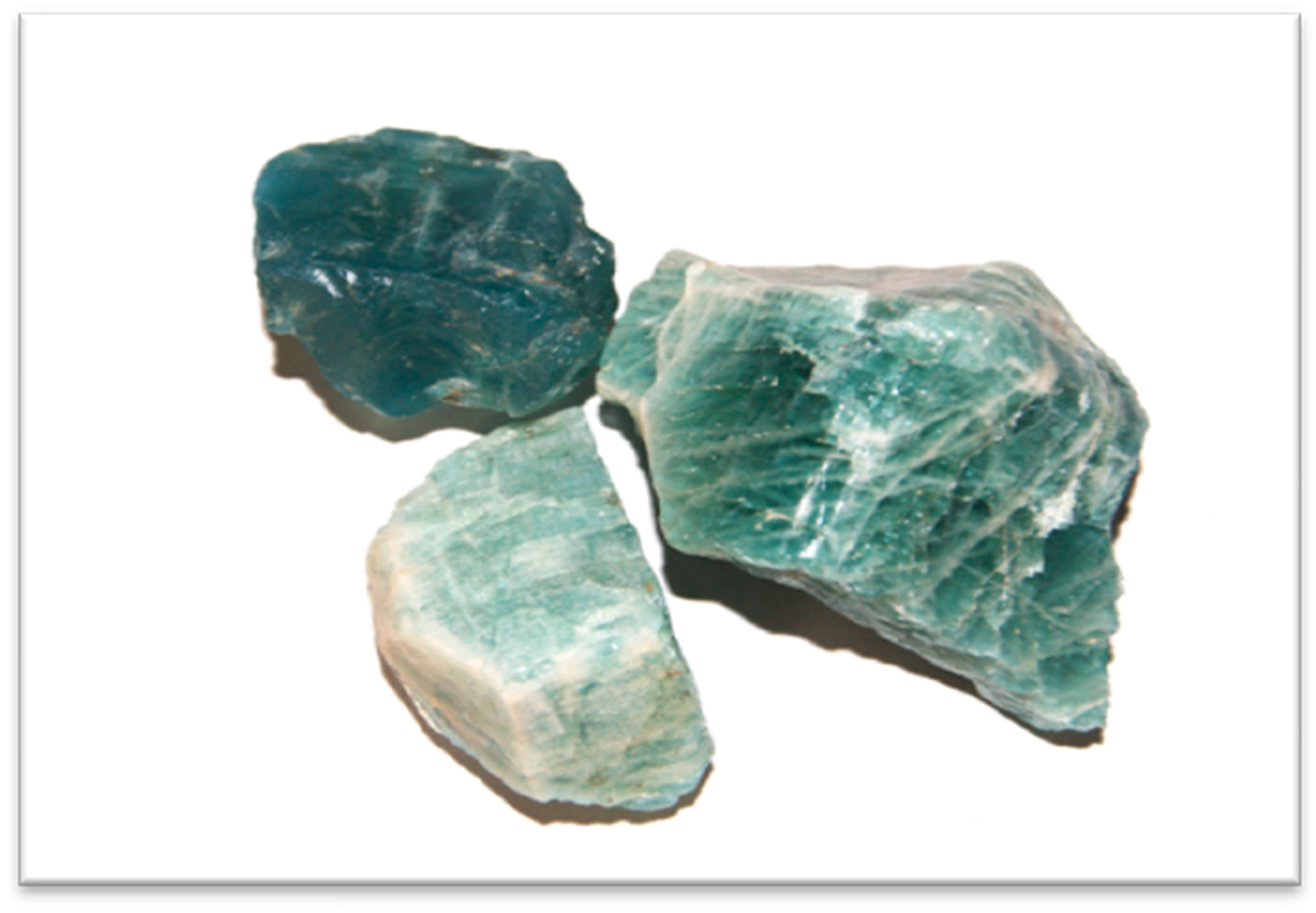
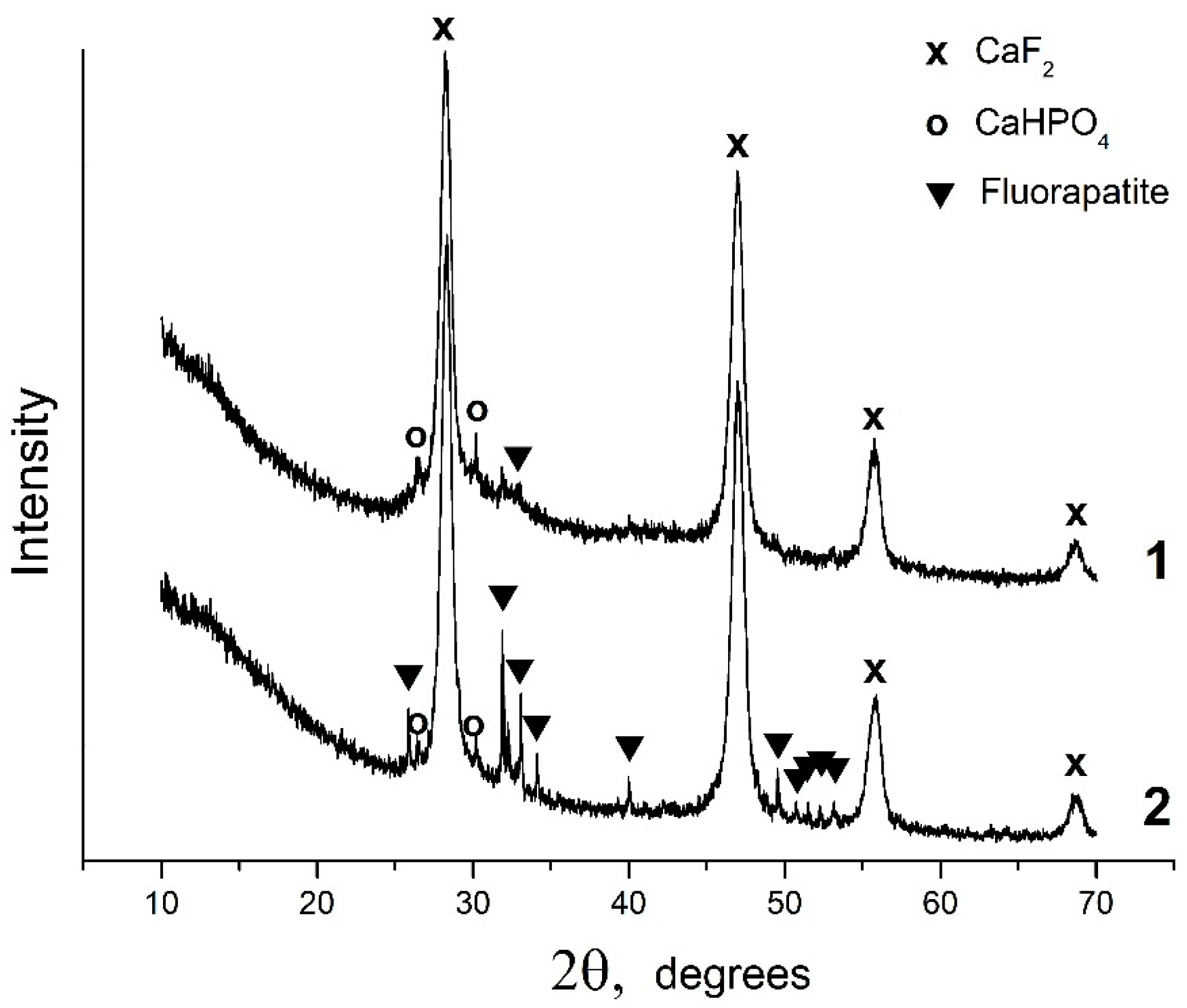

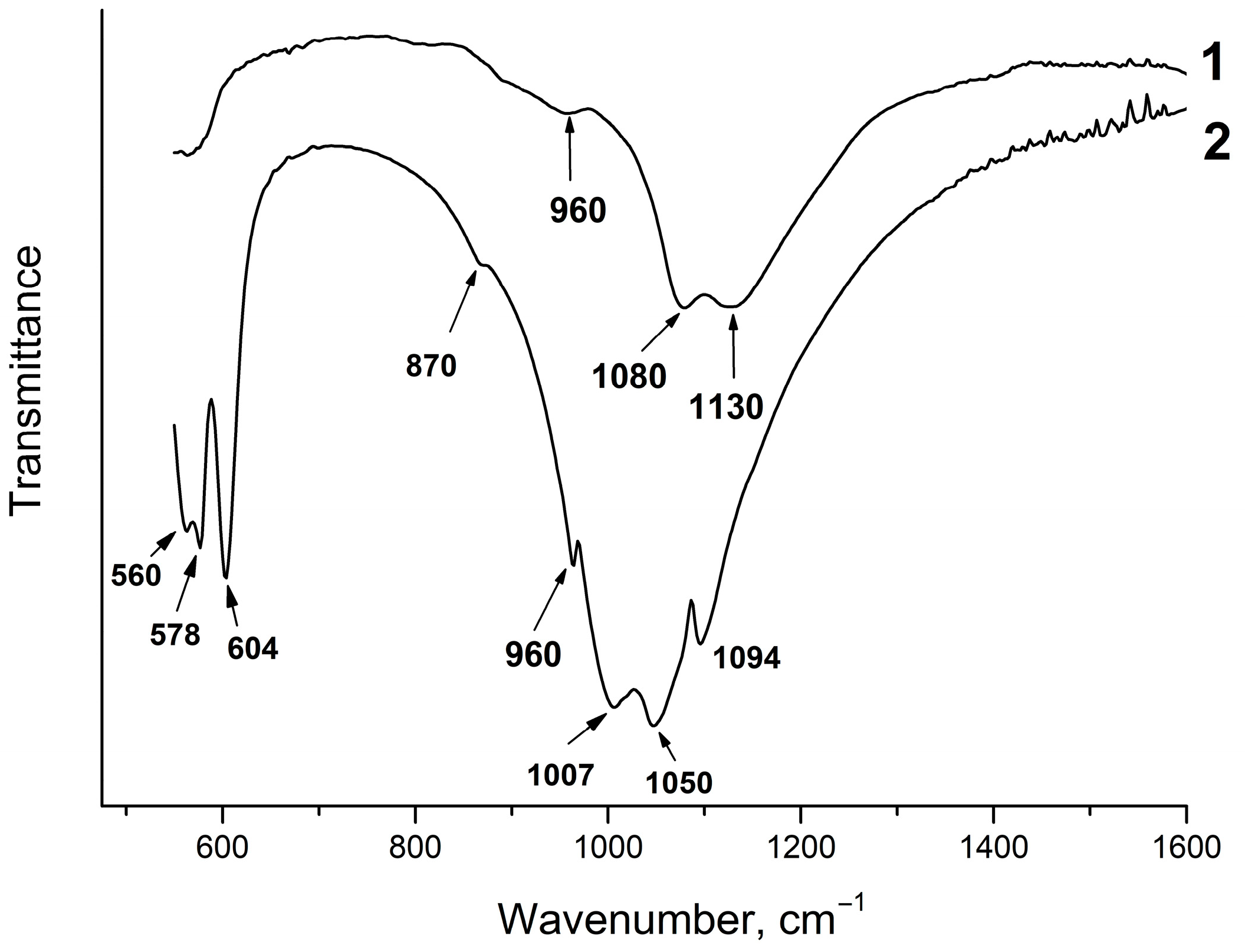
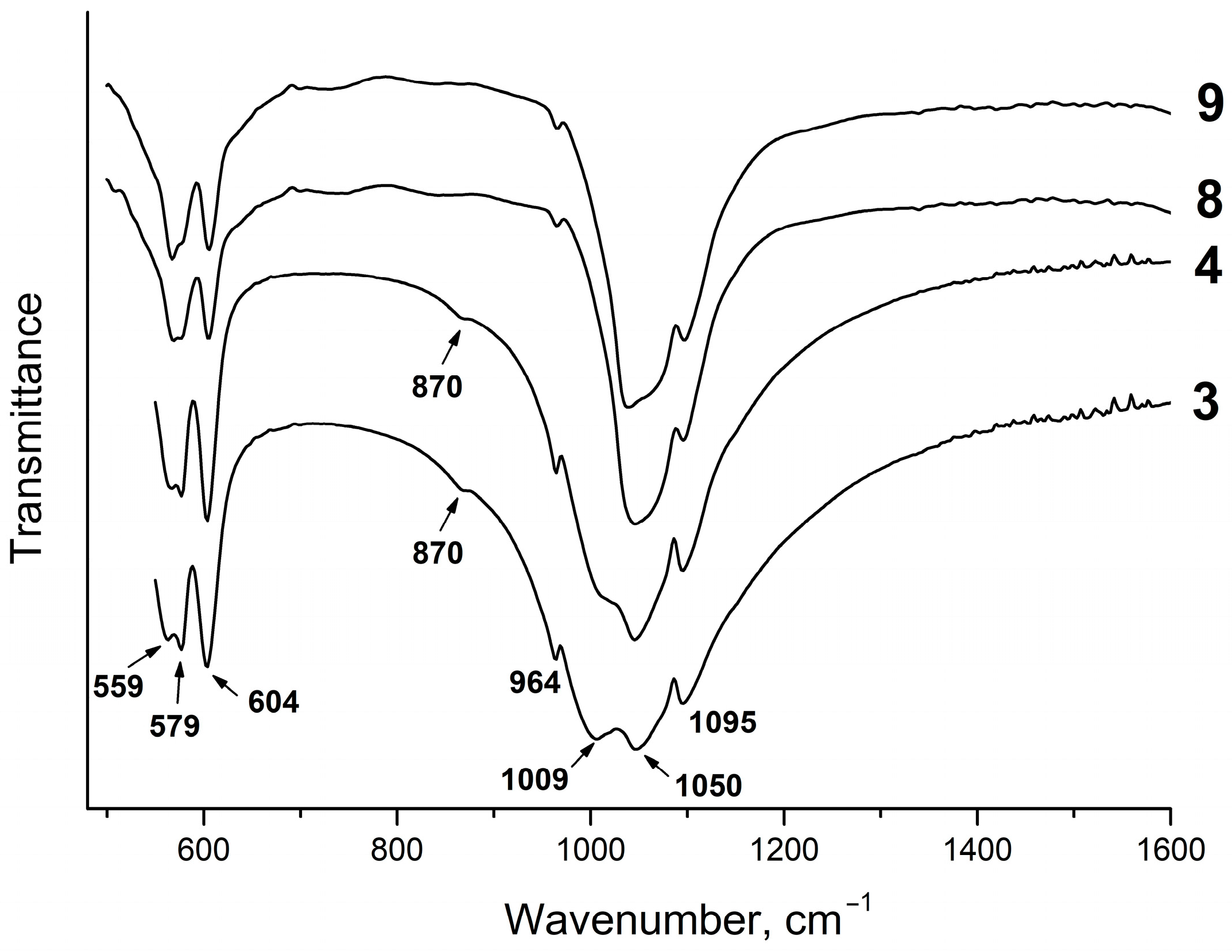
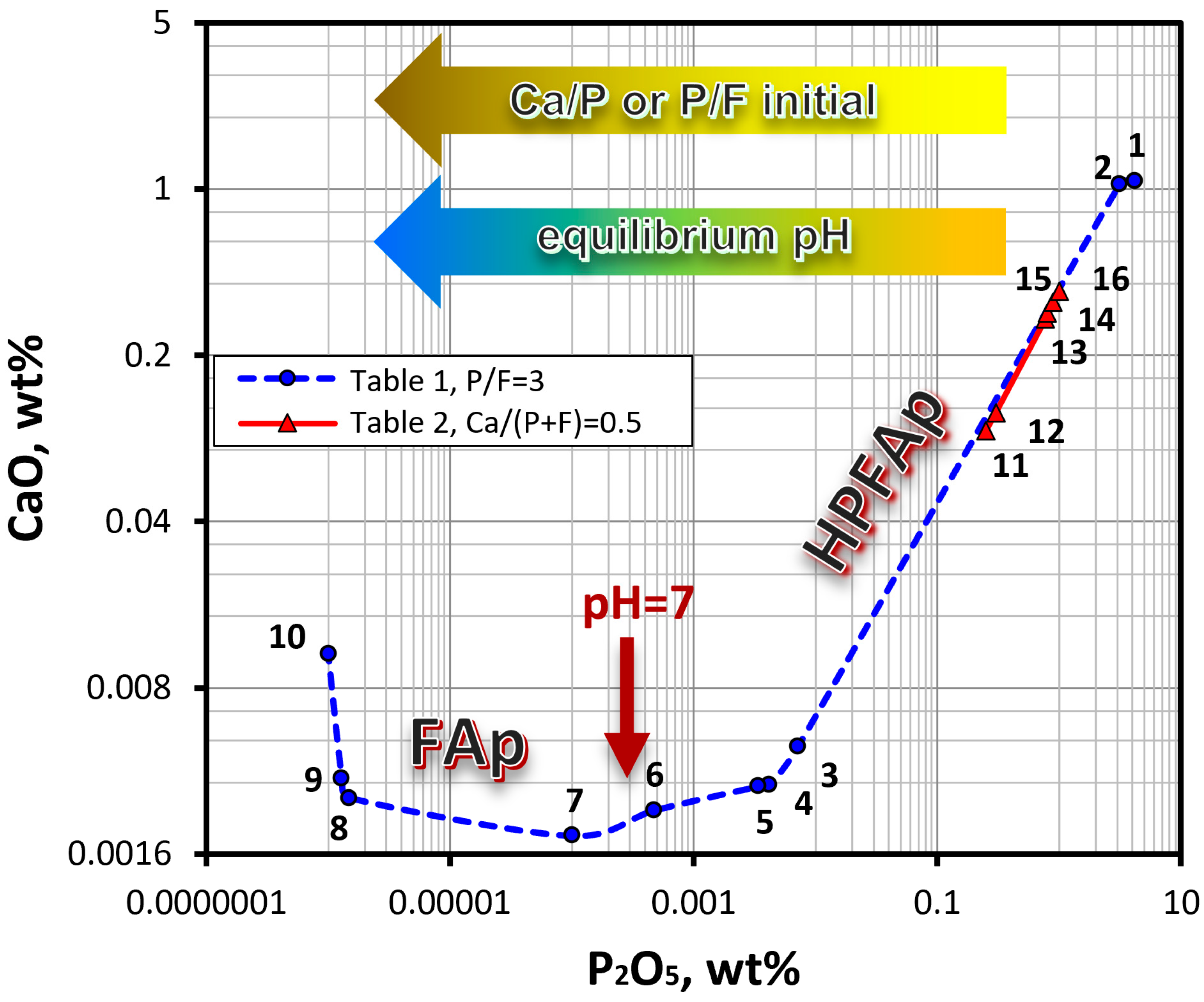
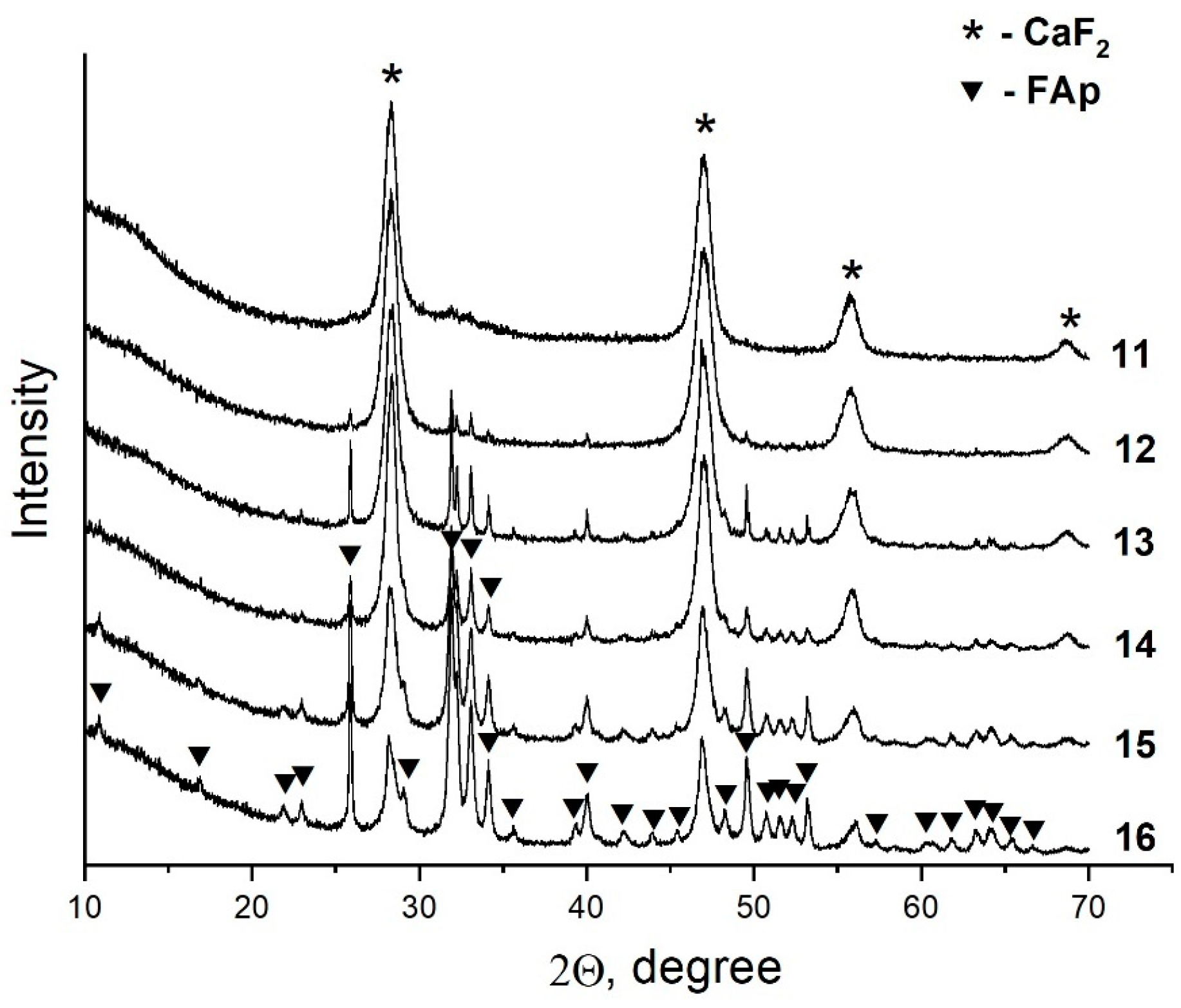
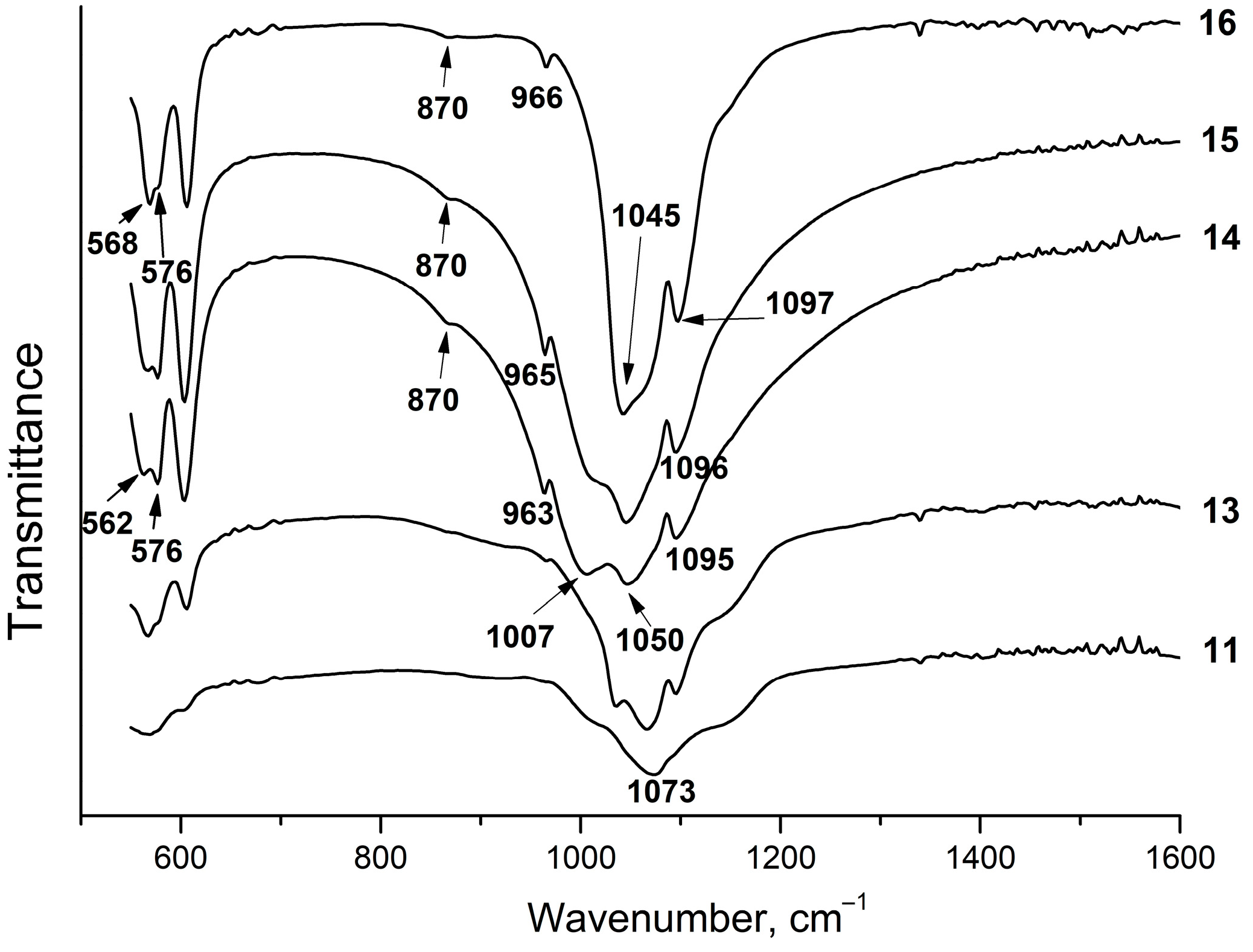
| No | Ca/P Ratio of Starting Components | Equilibrium Liquid Phase | Equilibrium Solid Phase | ||||||
|---|---|---|---|---|---|---|---|---|---|
| pH | Chemical Composition, wt% | Chemical Composition, wt% | Phase Composition | ||||||
| CaO | P2O5 | F | CaO | P2O5 | F | ||||
| 1 | 1.0 | 2.0 | 1.0750 | 4.1877 | 2.15 × 10−3 | 58.91 | 9.84 | 31.25 | A.P. + CaF2 + CaHPO4 |
| 2 | 1.1 | 1.84 | 1.0400 | 3.1270 | 1.85 × 10−3 | 52.44 | 15.80 | 31.76 | HPFAp + CaF2 + CaHPO4 |
| 3 | 1.3 | 5.34 | 0.0045 | 7.2 × 10−3 | 1.50 × 10−3 | 55.06 | 26.24 | 18.70 | HPFAp + CaF2 |
| 4 | 1.4 | 5.44 | 0.0031 | 4.2 × 10−3 | 1.43 × 10−3 | 56.51 | 20.34 | 23.15 | HPFAp + CaF2 |
| 5 | 1.5 | 5.52 | 0.0030 | 3.4 × 10−3 | 1.33 × 10−3 | 56.92 | 24.81 | 18.27 | HPFAp + CaF2 |
| 6 | 1.6 | 6.24 | 0.0024 | 0.47 × 10−3 | 1.18 × 10−3 | 60.41 | 32.15 | 7.44 | HPFAp + CaF2 |
| 7 | 1.7 | 7.10 | 0.0019 | 0.10 × 10−3 | 0.92 × 10−3 | 52.84 | 39.02 | 8.14 | FAp + CaF2 |
| 8 | 1.8 | 7.14 | 0.0027 | 0.015 × 10−3 | 0.90 × 10−3 | 60.42 | 21.74 | 17.84 | FAp + CaF2 |
| 9 | 1.9 | 7.58 | 0.0033 | 0.013 × 10−3 | 0.67 × 10−3 | 61.75 | 19.52 | 18.73 | FAp + CaF2 |
| 10 | 2.0 | 11.54 | 0.0111 | 0.010 × 10−3 | 0.41 × 10−3 | 69.81 | 13.84 | 16.35 | FAp + CaF2 + Ca(OH)2 |
| No | P/F Ratio of Starting Components | Equilibrium Liquid Phase | Equilibrium Solid Phase | ||||||
|---|---|---|---|---|---|---|---|---|---|
| pH | Chemical Composition, wt% | Chemical Composition, wt% | Phase Composition | ||||||
| CaO | P2O5 | F | CaO | P2O5 | F | ||||
| 11 | 1 | 3.26 | 0.097 | 0.252 | 0.46 × 10−3 | 59.35 | 11.04 | 29.61 | A.P. + CaF2 |
| 12 | 1.5 | 3.50 | 0.114 | 0.300 | 0.41 × 10−3 | 58.31 | 12.55 | 29.14 | HPFAp + CaF2 |
| 13 | 3 | 3.08 | 0.286 | 0.775 | 0.47 × 10−3 | 56.31 | 15.18 | 28.51 | HPFAp + CaF2 |
| 14 | 4 | 3.07 | 0.300 | 0.800 | 0.44 × 10−3 | 56.84 | 18.33 | 24.83 | HPFAp + CaF2 |
| 15 | 9 | 3.03 | 0.335 | 0.890 | 0.48 × 10−3 | 54.65 | 28.91 | 16.44 | HPFAp + CaF2 |
| 16 | 10 | 2.97 | 0.371 | 1.010 | 0.48 × 10−3 | 52.41 | 33.58 | 14.01 | HPFAp + CaF2 |
Disclaimer/Publisher’s Note: The statements, opinions and data contained in all publications are solely those of the individual author(s) and contributor(s) and not of MDPI and/or the editor(s). MDPI and/or the editor(s) disclaim responsibility for any injury to people or property resulting from any ideas, methods, instructions or products referred to in the content. |
© 2023 by the authors. Licensee MDPI, Basel, Switzerland. This article is an open access article distributed under the terms and conditions of the Creative Commons Attribution (CC BY) license (https://creativecommons.org/licenses/by/4.0/).
Share and Cite
Chaikina, M.V.; Bulina, N.V.; Prosanov, I.Y.; Ishchenko, A.V. Formation of Fluorapatite in the Equilibrium System CaO–P2O5–HF–H2O at 298 K in a Nitrogen Atmosphere. Crystals 2023, 13, 1264. https://doi.org/10.3390/cryst13081264
Chaikina MV, Bulina NV, Prosanov IY, Ishchenko AV. Formation of Fluorapatite in the Equilibrium System CaO–P2O5–HF–H2O at 298 K in a Nitrogen Atmosphere. Crystals. 2023; 13(8):1264. https://doi.org/10.3390/cryst13081264
Chicago/Turabian StyleChaikina, Marina V., Natalia V. Bulina, Igor Yu. Prosanov, and Arcady V. Ishchenko. 2023. "Formation of Fluorapatite in the Equilibrium System CaO–P2O5–HF–H2O at 298 K in a Nitrogen Atmosphere" Crystals 13, no. 8: 1264. https://doi.org/10.3390/cryst13081264
APA StyleChaikina, M. V., Bulina, N. V., Prosanov, I. Y., & Ishchenko, A. V. (2023). Formation of Fluorapatite in the Equilibrium System CaO–P2O5–HF–H2O at 298 K in a Nitrogen Atmosphere. Crystals, 13(8), 1264. https://doi.org/10.3390/cryst13081264







